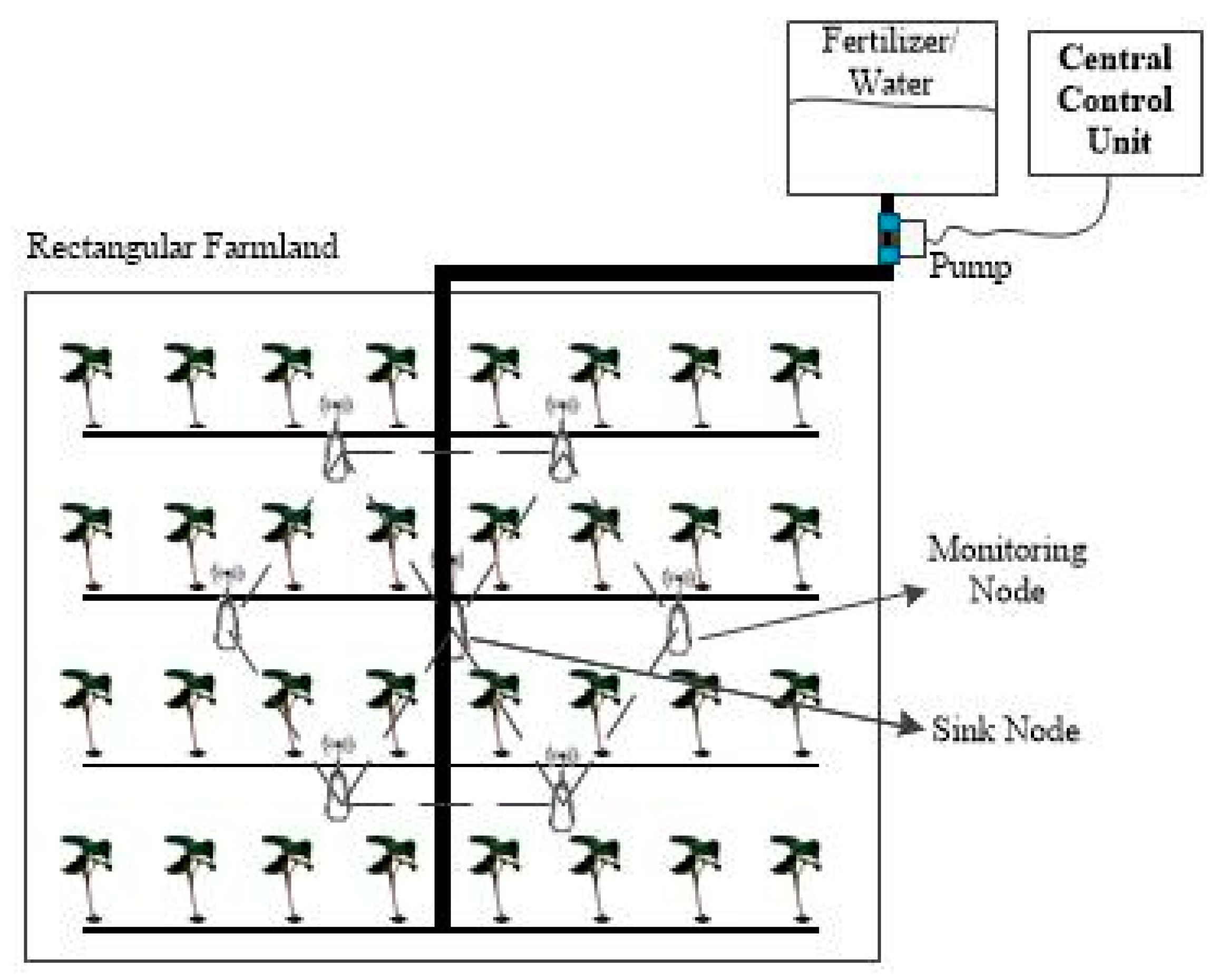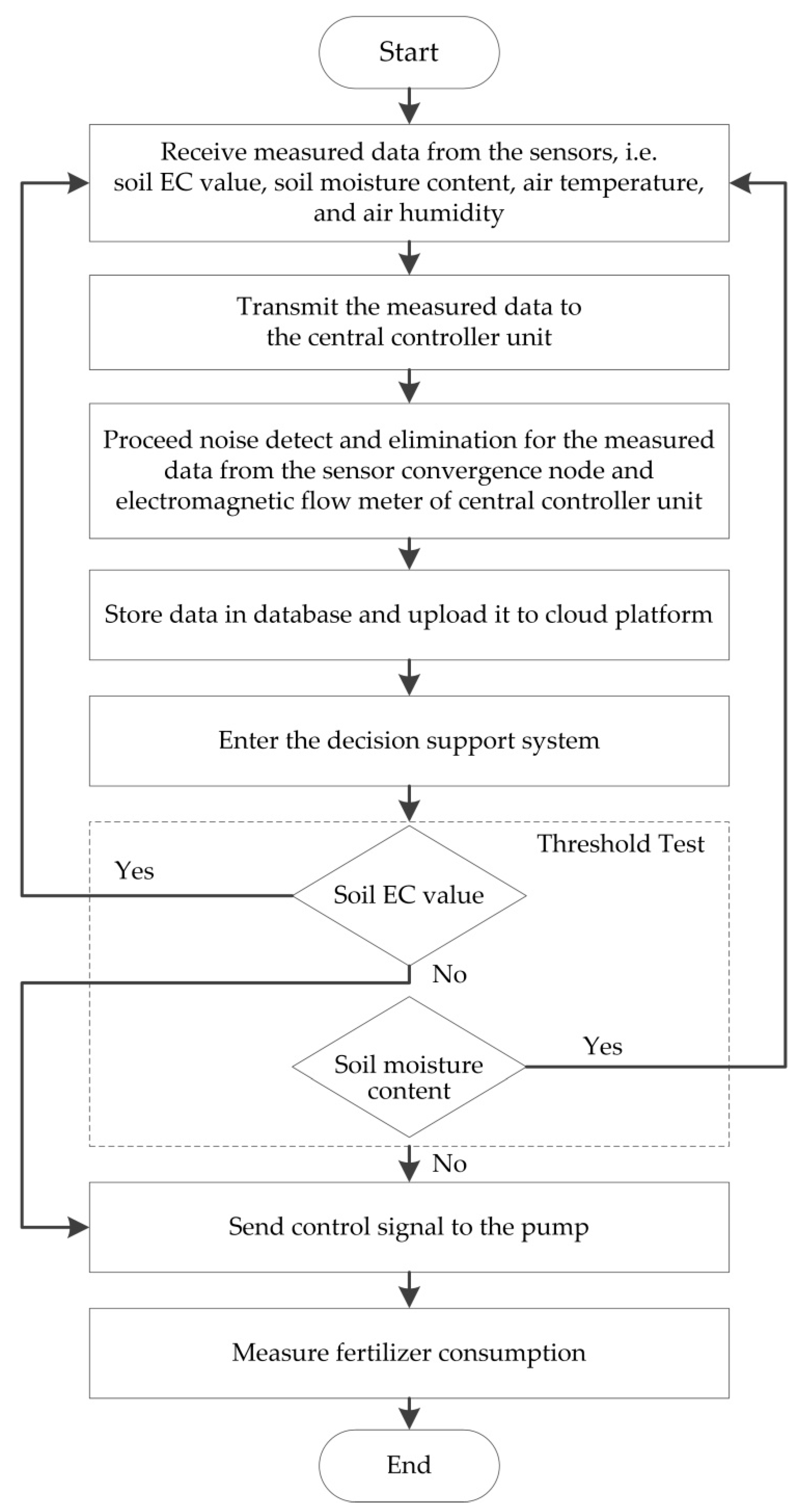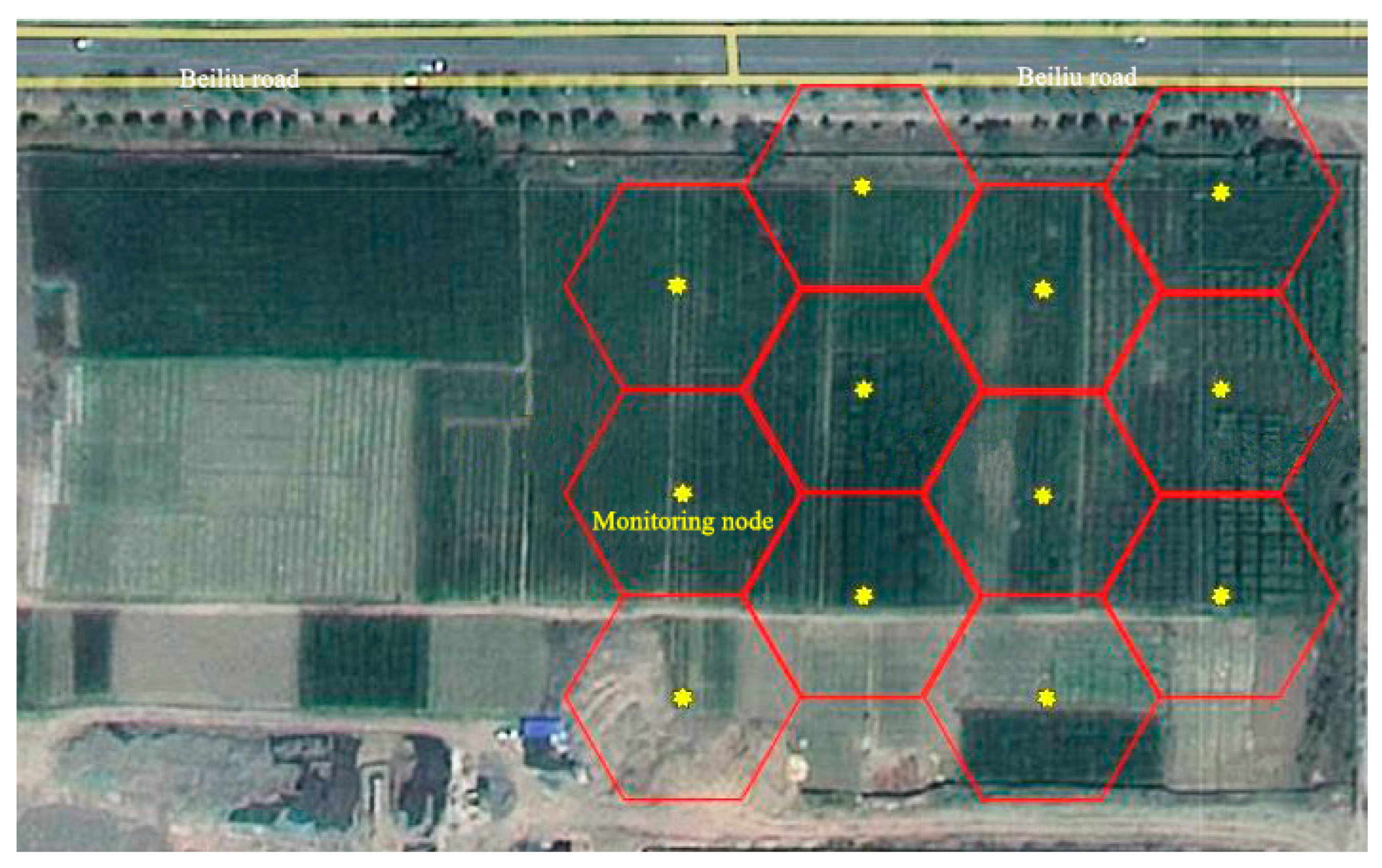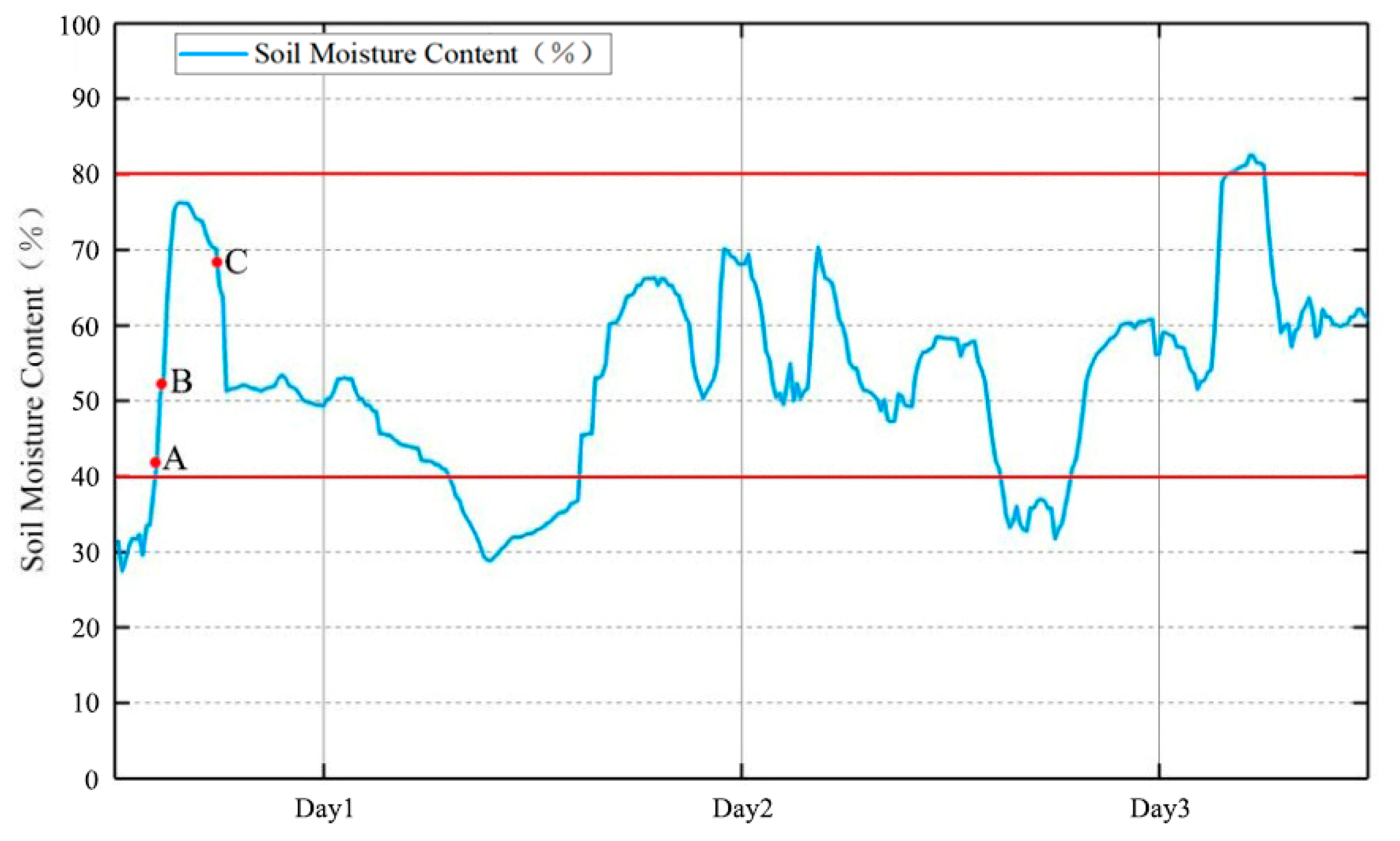A Cotton High-Efficiency Water-Fertilizer Control System Using Wireless Sensor Network for Precision Agriculture
Abstract
:1. Introduction
Sensor Node Deployment Scheme
2. Proposed Water-Fertilizer Control System
2.1. Noise Filtering Technology
2.2. System Architecture and Deployment
2.3. Proposed Decision Support System
3. Experimental Setup and Results
3.1. Experimental Setup
3.2. Data Processing
3.3. Analysis of Results
4. Discussion
5. Conclusions
Author Contributions
Funding
Institutional Review Board Statement
Informed Consent Statement
Data Availability Statement
Conflicts of Interest
References
- Pittelkow, C.M.; Liang, X.Q.; Linquist, B.A.; van Groenigen, K.J.; Lee, J.; Lundy, M.E.; van Gestel, N.; Six, J.V.E.; Venterea, R.T.; van Kessel, C. Productivity limits and potentials of the principles of conservation agriculture. Nature 2015, 517, 365–368. [Google Scholar] [CrossRef]
- Kader, A.; Senge, M.; Mojid, M.; Ito, K. Recent advances in mulching materials and methods for modifying soil environment. Soil Tillage Res. 2017, 168, 155–166. [Google Scholar] [CrossRef]
- Zheng, C.; Jiang, Y.; Chen, C.; Sun, Y.; Feng, J.; Deng, A.; Song, Z.; Zhang, W. The impacts of conservation agriculture on crop yield in China depend on specific practices, crops and cropping regions. Crop J. 2014, 2, 289–296. [Google Scholar] [CrossRef] [Green Version]
- Xiao, L.; Ding, M.; Wei, C.; Zhu, R.; Zhao, R. The Impacts of Conservation Agriculture on Water Use and Crop Production on the Loess Plateau: From Know-What to Know-Why. Sustainability 2020, 12, 7449. [Google Scholar] [CrossRef]
- Baryga, A.; Połeć, B.; Klasa, A. Quality of Sugar Beets under the Effects of Digestate Application to the Soil. Processes 2020, 8, 1402. [Google Scholar] [CrossRef]
- FAO; WHO. Evaluation of Certain Food Additives Eighty-Seventh Report of the Joint FAO/WHO Expert Committee on Food Additives; World Health Organization: Geneva, Switzerland, 2019; Volume 1020. [Google Scholar]
- Gan, L. Environmental risks of fertilizer use and the prevention and control measures in Chinese rural areas. Chim. OG-GI-Chem. Today 2016, 34, 33–38. [Google Scholar]
- Ajeng, A.A.; Abdullah, R.; Malek, M.A.; Chew, K.W.; Ho, Y.-C.; Ling, T.C.; Lau, B.F.; Show, P.L. The Effects of Biofertilizers on Growth, Soil Fertility, and Nutrients Uptake of Oil Palm (Elaeis Guineensis) under Greenhouse Conditions. Processes 2020, 8, 1681. [Google Scholar] [CrossRef]
- Lv, X.; Pan, D.-M. Research on the water-fertilizer integration and coordination management pattern of cotton with drip irrigation under mulch film. In Proceedings of the 2009 4th International Conference on Computer Science & Education, Nanning, China, 25–28 July 2009; pp. 929–932. [Google Scholar]
- Wang, C.; Zhao, C.; Zhang, X.; Qiao, X.; He, Y. Research and Exploitation of Precise Irrigation-Fertilization Controller. In Proceedings of the 2007 2nd IEEE Conference on Industrial Electronics and Applications, Harbin, China, 23–25 May 2007; pp. 172–175. [Google Scholar] [CrossRef]
- Liu, R.; Zhang, Y.; Ge, Y.; Hu, W.; Sha, B. Precision Regulation Model of Water and Fertilizer for Alfalfa Based on Agriculture Cyber-Physical System. IEEE Access 2020, 8, 38501–38516. [Google Scholar] [CrossRef]
- Canfora, L.; Malusà, E.; Salvati, L.; Renzi, G.; Petrarulo, M.; Benedetti, A. Short-term impact of two liquid organic fertilizers on Solanum lycopersicum L. rhizosphere Eubacteria and Archaea diversity. Appl. Soil Ecol. 2014, 88, 50–59. [Google Scholar] [CrossRef]
- Zhang, N.Q.; Wang, M.H.; Wang, N. Precision agriculture—A worldwide overview. Comput. Electron. Agric. 2002, 36, 113–132. [Google Scholar] [CrossRef]
- Hakkim, V.M.A.; Joseph, E.A.; Gokul, A.J.A.; Mufeedha, K. Precision Farming: The Future of Indian Agriculture. J. Appl. Biol. Biotechnol. 2016, 4, 68–72. [Google Scholar] [CrossRef] [Green Version]
- Xiuyun, X.; Xufeng, X.; Zelong, Z.; Bin, Z.; Shuran, S.; Zhen, L.; Tiansheng, H.; Huixian, H. Variable Rate Liquid Fertilizer Applicator for Deep-fetilization in Precision Farming Based on ZigBee Technology. IFAC-PapersOnLine 2019, 52, 43–50. [Google Scholar] [CrossRef]
- Yubin, Z.; Zhengying, W.; Lei, Z.; Weibing, J. The Control Strategy and Verification for Precise Water-Fertilizer Irrigation System. In Proceedings of the 2018 Chinese Automation Congress (CAC), Xi’an, China, 30 November–2 December 2018; pp. 4288–4292. [Google Scholar]
- Zhang, Y.; Wei, Z.; Lin, Q.; Zhang, L.; Xu, J. MBD of grey prediction fuzzy-PID irrigation control technology. Desalin. Water Treat. 2018, 110, 328–336. [Google Scholar] [CrossRef] [Green Version]
- Khriji, S.; El Houssaini, D.; Jmal, M.W.; Viehweger, C.; Abid, M.; Kanoun, O. Precision irrigation based on wireless sensor network. IET Sci. Meas. Technol. 2014, 8, 98–106. [Google Scholar] [CrossRef]
- Barkunan, S.R.; Bhanumathi, V.; Sethuram, J. Smart sensor for automatic drip irrigation system for paddy cultivation. Comput. Electr. Eng. 2019, 73, 180–193. [Google Scholar] [CrossRef]
- Chen, X.; Qi, Z.; Gui, D.; Sima, M.W.; Zeng, F.; Li, L.; Li, X.; Gu, Z. Evaluation of a new irrigation decision support system in improving cotton yield and water productivity in an arid climate. Agric. Water Manag. 2020, 234, 106139. [Google Scholar] [CrossRef]
- Das, J.; Cross, G.; Qu, C.; Makineni, A.; Tokekar, P.; Mulgaonkar, Y.; Kumar, V. Devices, Systems, and Methods for Automated Mon-itoring enabling Precision Agriculture. In Proceedings of the IEEE International Conference on Automation Science and Engineering, Gothenberg, Sweden, 24–28 August 2015; pp. 462–469. [Google Scholar]
- Rubio-Castro, E.; Ponce-Ortega, J.M.; Cervantes-Gaxiola, M.E.; Hernández-Calderón, O.M.; Ortiz-del-Castillo, J.R.; Milán-Carrillo, J.; Hernández-Martínez, J.F.; Meza-Contreras, J.A. Optimal design of integrated agricultural water networks. Comput. Chem. Eng. 2016, 84, 63–82. [Google Scholar] [CrossRef]
- Wang, Z.; Bian, Q.; Zhang, J.; Zhou, B. Optimized Water and Fertilizer Management of Mature Jujube in Xinjiang Arid Area Using Drip Irrigation. Water 2018, 10, 1467. [Google Scholar] [CrossRef] [Green Version]
- Wen, Y.; Wang, Z.; Guo, L.; Li, W. Establishing a Physiology-Yield-Quality Evaluation Model for Optimizing Drip Irrigation on Grape Fields in Extremely Arid Regions. Appl. Eng. Agric. 2021, 37, 267–278. [Google Scholar] [CrossRef]
- Steidle Neto, A.J.; Zolnier, S.; Lopes, D.D.C. Development and evaluation of an automated system for fertigation control in soilless tomato production. Comput. Electron. Agric. 2014, 103, 17–25. [Google Scholar] [CrossRef]
- Ullah, I.; Fayaz, M.; Naveed, N.; Kim, D. ANN Based Learning to Kalman Filter Algorithm for Indoor Environment Prediction in Smart Greenhouse. IEEE Access 2020, 8, 159371–159388. [Google Scholar] [CrossRef]
- Zheng, H. Design and application for greenhouse environment monitoring system based on ZigBee. J. Chang. Norm. Univ. 2018, 8, 42–45. [Google Scholar]
- Yang, F.; Xie, T.; Wu, Y.; Su, W. Design of monitoring system for greenhouse environment of agricultural Internet of Things based on WIFI. Jisuanji Celiang Yu Kongzhi 2017, 2, 50–53. [Google Scholar]
- Zou, J.; Chen, S.; Huang, Y.; Xing, Q. Spatiotemporal changes in cotton growing areas in XinJiang (2000–2015). Bangladesh J. Bot. 2017, 46, 1213–1224. [Google Scholar]
- Rawat, P.; Singh, K.D.; Chaouchi, H.; Bonnin, J.M. Wireless sensor networks: A survey on recent developments and potential synergies. J. Supercomput. 2014, 68, 1–48. [Google Scholar] [CrossRef]
- Feng, X.; Yan, F.; Liu, X. Study of Wireless Communication Technologies on Internet of Things for Precision Agriculture. Wirel. Pers. Commun. 2019, 108, 1785–1802. [Google Scholar] [CrossRef]
- Ferrandez-Pastor, F.J.; Garcia-Chamizo, J.M.; Nieto-Hidalgo, M.; Mora-Pascual, J.; Mora-Martinez, J. Developing Ubiquitous Sensor Network Platform Using Internet of Things: Application in Precision Agriculture. Sensors 2016, 16, 1141. [Google Scholar] [CrossRef] [Green Version]
- Soulis, K.X.; Elmaloglou, S. Optimum soil water content sensors placement for surface drip irrigation scheduling in layered soils. Comput. Electron. Agric. 2018, 152, 1–8. [Google Scholar] [CrossRef]
- Le, T.D.; Tan, D.H. Design and Deploy a Wireless Sensor Network for Precision Agriculture. In Proceedings of the 2015 2nd National Foundation for Science and Technology Development Conference on Information and Computer Science (NICS), Ho Chi Minh City, Vietnam, 16–18 September 2015; pp. 294–299. [Google Scholar]
- Haq, A. An improved mean deviation exponentially weighted moving average control chart to monitor process dispersion under ranked set sampling. J. Stat. Comput. Simul. 2013, 84, 2011–2024. [Google Scholar] [CrossRef]
- Aslam, M.; Bantan, R.A.R.; Khan, N. Design of S-N(2)—NEWMA Control Chart for Monitoring Process having Indeterminate Production Data. Processes 2019, 7. [Google Scholar] [CrossRef] [Green Version]
- Burnak, B.; Diangelakis, N.A.; Pistikopoulos, E.N. Towards the Grand Unification of Process Design, Scheduling, and Con-trol—Utopia or Reality? Processes 2019, 7, 461. [Google Scholar] [CrossRef] [Green Version]









Publisher’s Note: MDPI stays neutral with regard to jurisdictional claims in published maps and institutional affiliations. |
© 2021 by the authors. Licensee MDPI, Basel, Switzerland. This article is an open access article distributed under the terms and conditions of the Creative Commons Attribution (CC BY) license (https://creativecommons.org/licenses/by/4.0/).
Share and Cite
Du, C.; Zhang, L.; Ma, X.; Lou, X.; Shan, Y.; Li, H.; Zhou, R. A Cotton High-Efficiency Water-Fertilizer Control System Using Wireless Sensor Network for Precision Agriculture. Processes 2021, 9, 1693. https://doi.org/10.3390/pr9101693
Du C, Zhang L, Ma X, Lou X, Shan Y, Li H, Zhou R. A Cotton High-Efficiency Water-Fertilizer Control System Using Wireless Sensor Network for Precision Agriculture. Processes. 2021; 9(10):1693. https://doi.org/10.3390/pr9101693
Chicago/Turabian StyleDu, Chanchan, Lixin Zhang, Xiao Ma, Xiaokang Lou, Yongchao Shan, He Li, and Runmeng Zhou. 2021. "A Cotton High-Efficiency Water-Fertilizer Control System Using Wireless Sensor Network for Precision Agriculture" Processes 9, no. 10: 1693. https://doi.org/10.3390/pr9101693





